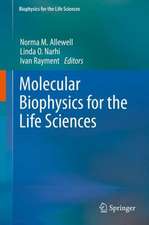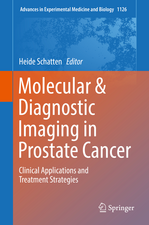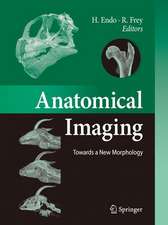Biological Low-Voltage Scanning Electron Microscopy
Editat de James Pawley, Heide Schattenen Limba Engleză Paperback – 12 sep 2014
| Toate formatele și edițiile | Preț | Express |
|---|---|---|
| Paperback (1) | 946.72 lei 6-8 săpt. | |
| Springer – 12 sep 2014 | 946.72 lei 6-8 săpt. | |
| Hardback (1) | 957.32 lei 6-8 săpt. | |
| Springer – 17 dec 2007 | 957.32 lei 6-8 săpt. |
Preț: 946.72 lei
Preț vechi: 1154.54 lei
-18% Nou
Puncte Express: 1420
Preț estimativ în valută:
181.18€ • 196.73$ • 152.19£
181.18€ • 196.73$ • 152.19£
Carte tipărită la comandă
Livrare economică 22 aprilie-06 mai
Preluare comenzi: 021 569.72.76
Specificații
ISBN-13: 9781489995841
ISBN-10: 1489995846
Pagini: 344
Ilustrații: X, 317 p.
Dimensiuni: 155 x 235 x 18 mm
Greutate: 0.48 kg
Ediția:2008
Editura: Springer
Colecția Springer
Locul publicării:New York, NY, United States
ISBN-10: 1489995846
Pagini: 344
Ilustrații: X, 317 p.
Dimensiuni: 155 x 235 x 18 mm
Greutate: 0.48 kg
Ediția:2008
Editura: Springer
Colecția Springer
Locul publicării:New York, NY, United States
Public țintă
ResearchDescriere
Major improvements in instrumentation and specimen preparation have brought SEM to the fore as a biological imaging technique. In FESEM, a field-emission cathode placed in the electron gun of a scanning electron microscope provides narrower probing beams and high electron energy. The result is improved spatial resolution and minimized sample charging and damage. Images produced are less destroyed and have a spatial resolution down to 1.5 nm, three to six times better than conventional SEM.
Although this imaging technique has undergone tremendous developments, it is still poorly represented in the literature, limited to journal articles and chapter s in books. This comprehensive volume is dedicated to the theory and practical applications of FESEM in biological samples. It provides a comprehensive explanation of instrumentation, applications, and protocols, and is intended to teach the reader how to operate such microscopes to obtain the best quality images.
Although this imaging technique has undergone tremendous developments, it is still poorly represented in the literature, limited to journal articles and chapter s in books. This comprehensive volume is dedicated to the theory and practical applications of FESEM in biological samples. It provides a comprehensive explanation of instrumentation, applications, and protocols, and is intended to teach the reader how to operate such microscopes to obtain the best quality images.
Cuprins
Table of Contents1. Low Voltage Scanning Electron Microscopy In Biology--Historical Preface :The Early Development of the Scanning Electron Microscope to 1965…1Dennis McMullan2. LVSEM For Biology...27James B. Pawley, PhD3. The Aberration-Corrected SEM...101David Joy Science and Engineering Research Facility, University of Tennessee4. Noise and its effects on the Low Voltage SEM...121David C Joy5. High-Resolution Low Voltage Field-Emission Scanning Electron Microscopy (HRLVFESEM) Applications for Cell Biology and Specimen Preparation Protocols...146Heide Schatten, PhD6. Molecular labeling for Correlative Microscopy: LM, LVSEM, TEM, EF-TEM and HVEM...173Ralph Albrecht and Daryl Meyer7. Low kV and video-rate, beam-tilt stereo for viewing live-time experiments in the SEM…209Alan Boyde8. CryoSEM of Chemically Fixed Animal Cells...228Stanley L. Erlandsen 9. High resolution and low voltage SEM of plant cells…249Guy Cox, Peter Vesk, Teresa Dibbayawan, Tobias I. Baskin and Maret Vesk10. High Resolution Cryo-Scanning Electron Microscopy of Biological Samples...268Paul Walther11. Developments in Instrumentation for Microanalysis in Low Voltage Scanning Electron Microscopy...305Dale E. Newbury
Recenzii
From the reviews:
"Topics ranging from the early development of the scanning electron microscope (SEM) to some of the latest low-voltage and cryo techniques are reviewed in detail. … this is a very useful volume for those wishing to learn, or refresh their memory, in the context of getting the best out of an SEM, and in particular the field emission SEM (FESEM)." (Iolo Ap Gwynn, infocus Magazine, Issue 12, December, 2008)
“Biological Low-voltage Scanning Electron Microscopy is an excellent and timely collection, written by many of the recognized experts in the subject … . Strongly recommended.” (Ultramicroscopy, Vol. 109, June, 2009)
"Topics ranging from the early development of the scanning electron microscope (SEM) to some of the latest low-voltage and cryo techniques are reviewed in detail. … this is a very useful volume for those wishing to learn, or refresh their memory, in the context of getting the best out of an SEM, and in particular the field emission SEM (FESEM)." (Iolo Ap Gwynn, infocus Magazine, Issue 12, December, 2008)
“Biological Low-voltage Scanning Electron Microscopy is an excellent and timely collection, written by many of the recognized experts in the subject … . Strongly recommended.” (Ultramicroscopy, Vol. 109, June, 2009)
Textul de pe ultima copertă
Field-emission, low-voltage scanning electron microscopy (LVSEM) is a field that has grown tremendously in recent years because is offers the optimal method for viewing complex surfaces at high resolution and in three dimensions. However, even though the instrumentation required to get good results at low beam voltage has become increasingly available, there has been a lag in its application to biological specimens. What seemed to be missing was volume that combined both the theory and practice of using this equipment in an optimal manner with a thorough treatment of biological specimen preparation.
Biological Low-Voltage Scanning Electron Microscopy is the first book to address both of these aspects of biological LVSEM. After providing a thorough description of the unique advantages and the operating constraints related to operating a scanning electron microscope at low beam voltage, the remainder of book focuses on the the best way to image all types of plant and animal cells and covers specimens that range from macromolecules to the surfaces revealed by de-embedding resin-embedded samples. Advanced specimen preparation techniques such as cryo-LVSEM, and immuno-gold-LVSEM are fully covered, as is x-ray microanalysis at low beam voltage and live-time stereo imaging. The preparative protocols provided represent the distilled essence of the experience of a group of world-renowned authors who have, for many decades, been instrumental in developing and applying new approaches to LVSEM to support their own biological research.
Biological Low-Voltage Scanning Electron Microscopy is the first book to address both of these aspects of biological LVSEM. After providing a thorough description of the unique advantages and the operating constraints related to operating a scanning electron microscope at low beam voltage, the remainder of book focuses on the the best way to image all types of plant and animal cells and covers specimens that range from macromolecules to the surfaces revealed by de-embedding resin-embedded samples. Advanced specimen preparation techniques such as cryo-LVSEM, and immuno-gold-LVSEM are fully covered, as is x-ray microanalysis at low beam voltage and live-time stereo imaging. The preparative protocols provided represent the distilled essence of the experience of a group of world-renowned authors who have, for many decades, been instrumental in developing and applying new approaches to LVSEM to support their own biological research.
Caracteristici
First book to focus on biological application of LVFESEM
Teaches the reader how to operate such microscopes to obtain the best quality images
This imaging technique is poorly represented in the literature, limited to journal articles and chapters in books
Teaches the reader how to operate such microscopes to obtain the best quality images
This imaging technique is poorly represented in the literature, limited to journal articles and chapters in books























